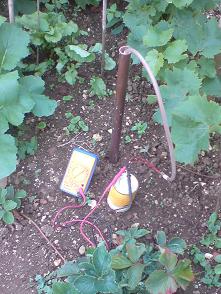Until recently the most common source of wind speed data was weather reports from airfields. These are large open spaces and the weather station is usually located somewhere close to the point of touchdown where its data will make the greatest contribution to aircraft safety. This is in contrast to most residential and commercial areas which are cluttered with buildings, trees and infrastructure such a bridges all of which might be crammed into hillsides and valleys. In the past few years, data from small weather stations mounted in backyards has become available. The two sources give different impressions, typically, airfields have a average annual wind speed in roughly in the range 4 - 7 m/s, whilst backyards might experience 1 - 4 m/s. As with all gross generalisations, there are exceptions, but my own backyard sitting on the sheltered side probably has an average of around 1 m/s based on many calm days and a few gusty ones.
Wind speed measurements are typically taken at a standard height of 10m although there are some important exceptions, for offshore buoys it is often 4 - 5 m, for offshore platforms it can be well over 100m (to assist helicopter operations). Private weather stations can be at any height available to the owner. However, they are generally located at the base of the boundary layer which is not an ideal place to put a wind turbine. Utility scale machines are mounted on towers, typically 100 metre tall which lift the rotor out of the turbulent and complex air flows found around roof and tree tops. The photo shows a medium sized wind turbine mounted on a tall tower in an urban location:
However, this type of structure is not practical/acceptable in the average backyard, so wind found at approximately 10 metres is the the resource that is available to most people (subject to neighbours, town planning and building regulations which keep towns and cities safe and relations between residents harmonious).
The plan was to cycle around the town taking wind speed measurements at a variety of locations and compare them to data from a small airfield a few km to the west. In a failed attempt to introduce an element of street theatre I took a small model of a Savonius wind turbine with me.
Whatever other merits it may possess, the Savonius design can withstand the rough handling that comes from being strapped to the back of a bike.
During seven outings I found about 20 locations where I could take measurements. With the single exception of a curious dog, this bizarre activity attracted no attention. The locations included the seafront and a breakwater, the roofs of multi-story car parks and my own backyard. One days results are shown in graphic form below:
Moderate winds at the airfield are usually smooth and there is a good relationship between the wind there and that experienced on the sea front. In these places the Savonius model would spin continuously when the wind was greater than 3 m/s. However, in the town, suburbs and parks the wind was usually attenuated and turbulent, the graphic is a sketch of the relationship between "clear" and "urban" wind:
The rooves of car parks were the most interesting, all five locations were well above surrounding roof tops, yet in all cases, the wind was turbulent and it was rare for the Savonius model to spin continuously. Having seen several horizontal axis wind turbines in urban locations they often appear to "hunt" for the wind then spin up and down with the gusts. The vertical axis Savonius was usually quick to respond to gusts, however, the coefficient of performance is low. The coefficient of performance is the fraction of the wind's energy that the turbine manages to extract.
The relationship between wind speed and power is cubic, thus a 5 m/s wind has almost five times the energy of one of 3 m/s, the relationship is complicated by variations in a turbine's coefficient to performance with wind speed. In general, the coefficient of performance declines with increasing turbulence.
It is probable that a suburban area with low and widely spaced housing on flat land might give more encouraging results, but in a densely populated English town, small wind turbines have limited potential for generating significant amounts of energy. The greatest potential for wind energy appears to be large turbines located offshore where average annual wind speeds are significantly higher than those onshore. However, offshore wind is still a weather/climate dependent energy source.












